Motorsports
Central European Rally Saturday morning highlights
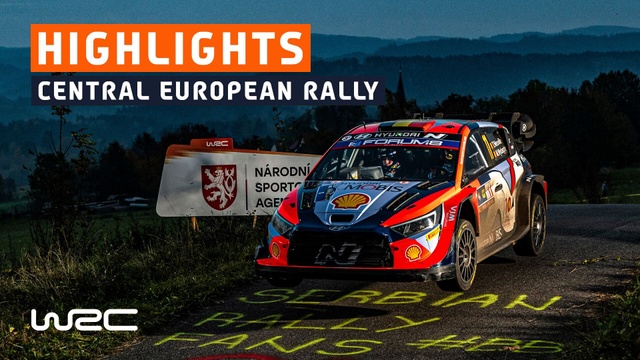
Continue reading with advertising …
… or with a subscription
Visit motorsport.com as usual with advertising and tracking. You can revoke your consent at any time via the data protection page.1
Use motorsport.com without any advertising banners, personalized tracking and commercials for a small fee.
More information about advertising and tracking in our Data protection notice, the List of our partners and in Data protection information center.
Already a subscriber?
Log in here
Motorsports
Double Interview with Nicklas Nielsen and Antonio Fuoco
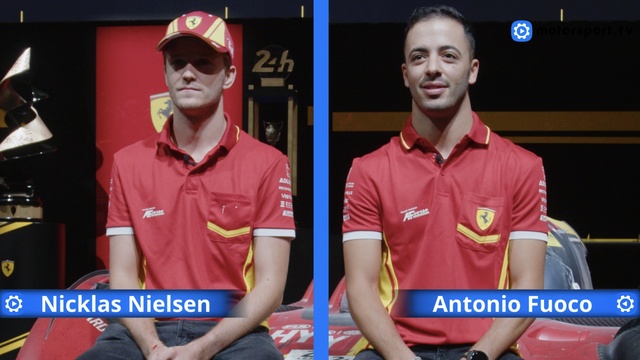
Continue reading with advertising …
… or with a subscription
Visit motorsport.com as usual with advertising and tracking. You can revoke your consent at any time via the data protection page.1
Use motorsport.com without any advertising banners, personalized tracking and commercials for a small fee.
More information about advertising and tracking in our Data protection notice, the List of our partners and in Data protection information center.
Already a subscriber?
Log in here
Motorsports
Ogier responds to Tanak pace to extend advantage
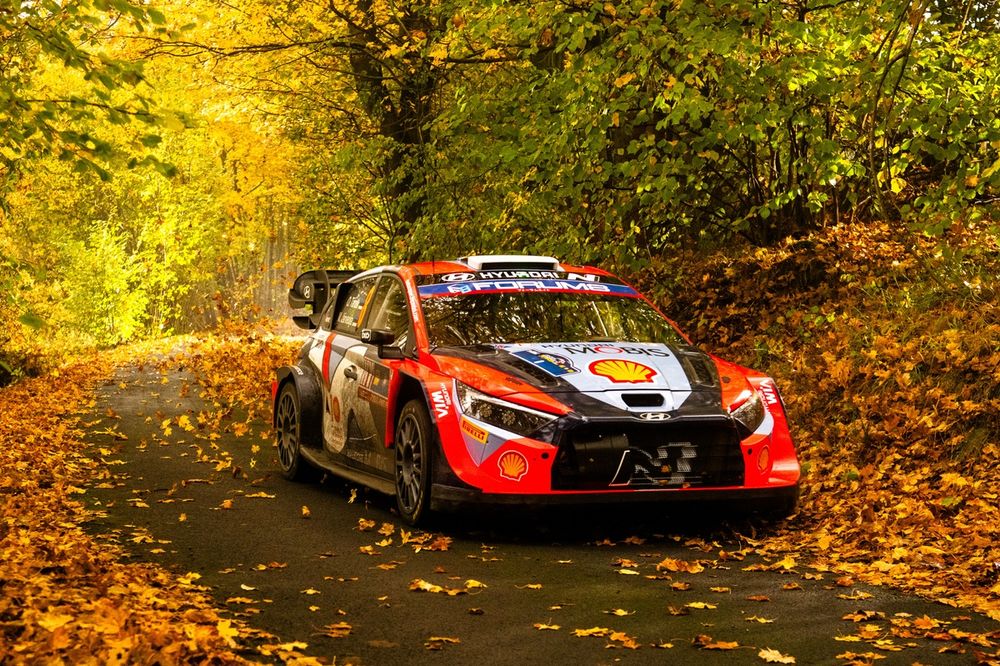
Toyota’s Sebastien Ogier will take a slender lead over Hyundai’s Ott Tanak as 14s separated the top three heading into the final four stages of the Central European Rally.
The eight-time world champion won two of the three afternoon asphalt stages to extend his advantage over Tanak to 5.2s, with Toyota’s Elfyn Evans in third and 14s back.
Ogier’s performance earned the Frenchman 18 provisional championship points to boost Toyota’s manufacturers’ title hopes, while Tanak picked up 15 points and Evans claimed 13.
Championship leader Thierry Neuville ended the day in fourth, 39.8s back on the overall lead, to claim 10 provisional championship points, after two errors in the morning’s stage 11 cost him half a minute and the rally lead.
It proved to be a setback for the Belgian, who can seal a maiden world title if he can outscore Tanak by two points.
Toyota’s Takamoto Katsuta, team-mate Sami Pajari and M-Sport’s Gregoire Munster rounded out the top seven. M-Sport’s Adrien Fourmaux retired from the day’s action after damaging the rear of his Ford Puma in stage 10.
Neuville’s demise in the morning put attention firmly on the fight for the rally lead between Ogier, Tanak and Evans as the trio had been separated by 8.1s.
Ott Tänak, Martin Järveoja, Hyundai World Rally Team Hyundai i20 N Rally1
Photo by: Red Bull Content Pool
The afternoon’s first stage, a second pass through Granit und Wald (20.05km), went the way of Tanak as the Hyundai driver repeated the stage win from the morning pass.
The stage was mostly dry, unlike the morning, but there were still a few “sketchy” damp patches according to Tanak. The 2019 world champion’s effort was 3.4s faster than rally leader Ogier’s, which reduced the Toyota driver’s lead to a mere 1.1s.
Evans also pushed hard on the dirty road, matching Ogier’s time to remain poised in third overall.
Resigned to the fact that the gap to lead group was too large to claw back, Neuville delivered a steady run to clock the fourth-fastest time ahead of Katsuta, Pajari, Mikkelsen and Munster.
Katsuta did have 16 seconds added to his overall time after he was found to have exceeded the speed limit by 8km/h through the virtual chicane in the morning pass through the test.
Ogier responded to Tanak’s push in stage 13 (Beyond Borders, 24.33km) by winning the test and crucially taking three seconds out of his Hyundai rival. The road was much drier compared to the morning pass.
“We had to react, Ott was fast in the previous, we had to be fast on this. It is a drier road, so we have to be better on it,” said Ogier.
Thierry Neuville, Martijn Wydaeghe, Hyundai World Rally Team Hyundai i20 N Rally1
Photo by: Fabien Dufour / Hyundai Motorsport
Neuville was Ogier’s nearest rival on the stage, 0.9s adrift, as the WRC points leader focused on bringing the car home, as both Tanak and Evans dropped time to Ogier.
“In the dry conditions, a lot of markings have improved, I had a bit of hesitation in there. I should learn to ignore what my old man [father, Gwyndaf Evans] says sometimes!” Evans said. “He’s doing my gravel notes, you have to take everything with a pinch of salt but it’s not always that easy to do.”
Ogier managed to pull further clear of Tanak on the final stage of the day after eclipsing the Hyundai driver’s time by 1.1s, with Evans two seconds adrift of the pace to set up an intriguing three-way fight for the victory on Sunday.
In WRC2, Nikolay Gryazin opened up a 1m50.8s lead over Filip Mares, while Yohan Rossel’s championship hopes are all but over after a mistake in the morning left him 11th in class and 15m40.7s in arrears.
The rally will conclude after four Sunday stages comprising of 54.04km.
Motorsports
The US Grand Prix’s rocky past and fascinating future at COTA
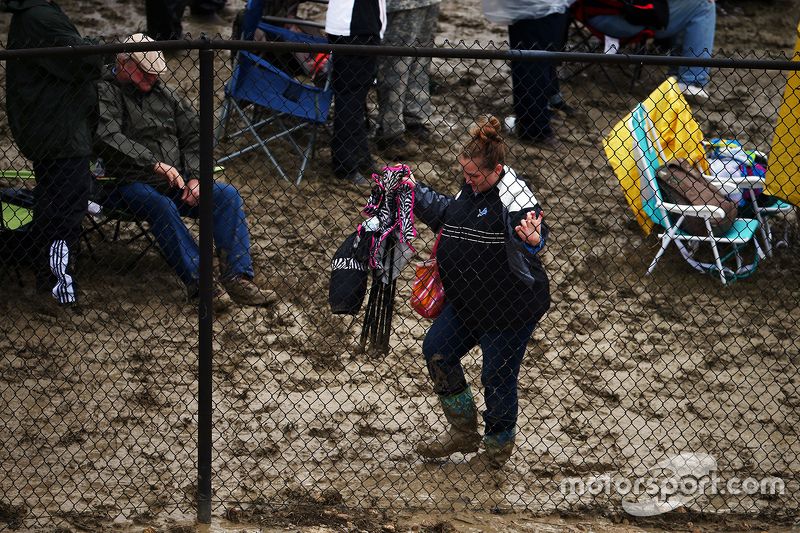
It’s been nearly 10 years since the 2015 Formula 1 United States Grand Prix. But if I close my eyes, I can still see it.
It was Saturday — qualifying day — and my 20th birthday. I was a college student in the garage at Circuit of The Americas, with a media credential and a few professors angry I’d skipped their classes to work in the field I was studying to join. I wore rain boots up to my knees and clutched an umbrella so close to my head that I could barely see in front of me. When I did look up, I saw a smattering of fans in the stands, all peering through ponchos. The F1 cars splashed by so violently that it felt more like I was watching a water-park ride than a racetrack.
Fans in the mud
Photo by: XPB Images

Spectators waded through mud, rain, and flooding for a dreary weekend of racing, followed by an even drearier set of headlines:
“The end of F1 in Austin? U.S. Grand Prix might not be back next year“
“Why the future of Formula One in Austin looks a little murky“
“Questions about future of Formula One’s U.S. Grand Prix as Texas cuts funds“
“U.S. Grand Prix ‘subject to agreement’ on 2016 Formula 1 calendar“
“Bernie Ecclestone casts more doubt on 2016 USGP“
That rainy day, and those headlines, feel like a lifetime ago. Yet it’s merely a blip in America’s long and rocky history with F1 riddled with safety concerns, crumbling track surfaces, entire races falling to pieces right in front of spectators’ eyes, and more. These catastrophic events happened at tracks all over the country, and they led F1 to leave the US market again, and again, and again. That rainy day in 2015 was a pivotal moment for F1 in America, and I thought it would end like all the rest: with F1 leaving us behind to try again later.
But somehow, F1 in America didn’t just survive that 2015 flood — it crawled from obscurity into the limelight, all with Circuit of The Americas at the center of it. Heading into this 2024 race weekend, F1 at COTA isn’t the same event I worried we’d lose all those years ago.
F1 at Circuit of The Americas: The Early Years
Circuit of The Americas sits just outside of Austin, Texas. Famous F1 track designer Hermann Tilke created the track, and it opened to the public in October 2012, when F1 champion Mario Andretti ripped the first few laps. The inaugural F1 race happened a month later and broke a five-year absence from the American market, all spurred by the series’ infamous tire disaster at Indianapolis Motor Speedway.

Sebastian Vettel, Red Bull Racing
Photo by: XPB Images
When COTA opened in 2012, it was America’s big, shiny, purpose-built F1 track, with new facilities, a giant watchtower looking over the course, and vast star-spangled runoff areas to meet modern F1 safety standards. It’s a 20-turn, 3.41-mile circuit with a mix of high-speed straightaways, harsh braking zones, and momentum-based turns like the esses and carousel, and it’s my personal favorite track to drive.
For the most part, COTA is still America’s premiere F1 facility. The series’ new US tracks in Miami and Las Vegas are street circuits, and while they are glamorous, they don’t have that same permanent footprint. (The biggest mistake the builders made at COTA was not planting trees, because it’s been 12 years and there’s still not a square inch of natural shade.)
But there were hesitations about COTA from the start. When the circuit opened, the local Austin Chronicle wrote about resident hesitation, funding and subsidization concerns, and F1’s rocky history in America—all things that would soon plague the race and venue.
Pestilence, Destruction, and (Avoidance of) Death
The first US Grand Prix at COTA in 2012 had a three-day attendance of 265,000 and a race-day attendance of 117,429, but the numbers fell from there.
The 2013 race had 250,000 weekend spectators, 2014 had 237,000, and the rainy 2015 race had 224,000. My mom went to the track and co-headlining Elton John concert in 2015, and she called the race “dismal and muddy.” When she got surprise tickets to the ultra-expensive indoor Paddock Club with me, she said that she felt like “Cinderella in her dirty cleaning clothes.”
The COTA attendance numbers didn’t get drastically worse from year to year, but they did get worse, adding up to a weekend drop of about 41,000 in four years. Austin residents also tend to get invested in their local events — University of Texas football games, the Austin City Limits music festival, and the like. But my Italian professor made me ask permission (in Italian) to skip class for a ride-along with F1 legend Sebastian Vettel, and my audio-journalism professor acted like me working the race was an inconvenience. This lack of enthusiasm came because they — and others — didn’t consider F1 to be a true Austin event yet. True Austin events are always worth attending.
The opportunity for it to become a true Austin event nearly escaped, quite prematurely. Just after the 2015 race, storms bashed COTA. Rains flooded the (very tall) traffic tunnels leading into the infield, and the storm knocked over trams, flattened temporary buildings, and ripped seats out of the main grandstands. A rock wall got hit so hard it fell apart, and an awning got ripped off of a nearby gas station.
While the storm raged, so did discussions about whether the state would or should keep funding the race. When F1 released its 2016 calendar, the US Grand Prix had an asterisk by its listing: *subject to agreement with the promoter and the National Sporting Authorities. The U.S. Grand Prix was, once again, in doubt.
The USGP needed a boost, so in 2016, the event organizers brought in the big act: Taylor Swift. It was advertised as her first and only concert of the year, and it brought in an estimated 80,000 attendees.
Taylor Swift in concert
Photo by: Jerry Andre / Motorsport Images

All of this made sense in 2016, when F1 in the U.S. needed an attendance boost and beacon of hope. But in 2024, it’s unthinkable. It’s hard to imagine Swift, whose extensive Eras Tour averaged 72,000 attendees per show according to reports in 2023, being an add-on to a sporting event instead of her own show, and it’s hard to imagine that F1 would even need her help in America.
I remember sitting in the media center in 2016, looking at live traffic maps to see when to leave the track. (This is necessary at COTA, since a couple of two-lane roads lead into a venue with a six-figure capacity.) The map leading into COTA after the on-track activities ceased was solid red, because the concert-goers opted for music only. Forget the race cars.
Things were bad. When the COVID-19 pandemic hit and canceled the 2020 USGP, it could’ve been worse.
But then, the “Drive to Survive” effect happened.
Staying Unique in a Saturated U.S. Market
Netflix’s F1 docuseries, “Drive to Survive,” exploded in popularity as Americans sat at home during pandemic lockdowns. So did F1.

Charles Leclerc, Ferrari, and Pierre Gasly, AlphaTauri, in the drivers parade, flanked by the Dallas Cowboys Cheerleaders
Photo by: Andy Hone / Motorsport Images
The return to COTA for the 2021 US Grand Prix saw a weekend attendance of 400,000, setting a new record for F1 while the series scrambled to capitalize on its American boom. The Miami Grand Prix joined the calendar for 2022, and the Las Vegas Grand Prix — a race down Vegas’ famous Strip, with casinos on either side of the track — debuted in 2023. America became an F1 hotbed, hosting three of the series’ 24 global races this year.
Now, after deep lows and record highs, COTA faces a new challenge: defining itself in an era where it’s the US Grand Prix in name only, since there are now three US Grands Prix. When F1 returned to the US after its pandemic cancellation and “Drive to Survive” boom, COTA was the main option for new American F1 fans. It was like the one diner in a small town: It didn’t have to stand out, because everyone had to go there anyway.
But now, that town has a Cheesecake Factory and a Chili’s. There’s competition, with freshly polished dining tables and multi-page menus with coil bindings. The local diner is still a staple, but there are tempting distractions.
The way forward for the US Grand Prix at COTA, I think, is to lean into Texas culture. Miami is the club and beach hotspot, Vegas is the glitzy night race, and Austin should be the Wild West race. The appeal of F1 races around America shouldn’t just be their geographic proximity to spectators, but also what kind of culture they offer. In Austin, that culture is modern cowboys and live music.
Sir Jackie Stewart meets a Texas Longhorn
Photo by: Mark Sutton / Motorsport Images

It might feel like an elaborate cosplay for locals, but all of this is cosplay in some form. The Miami race is a giant parking lot, and Vegas is a city of overpriced knockoffs, yet both feel glamorous because that’s what they’re advertised to be. These events are what we—and the race promoters—make of them.
I’ve experienced every era of F1 in Austin, from the torrential floods of 2015 to the bright, sunny days post-”Drive to Survive.” Each of them feels like a lifetime ago, and hopefully, F1 in the US has many lifetimes to go.
Motorsports
How a 3mph difference squeaked Verstappen ahead of Russell in Sprint qualifying
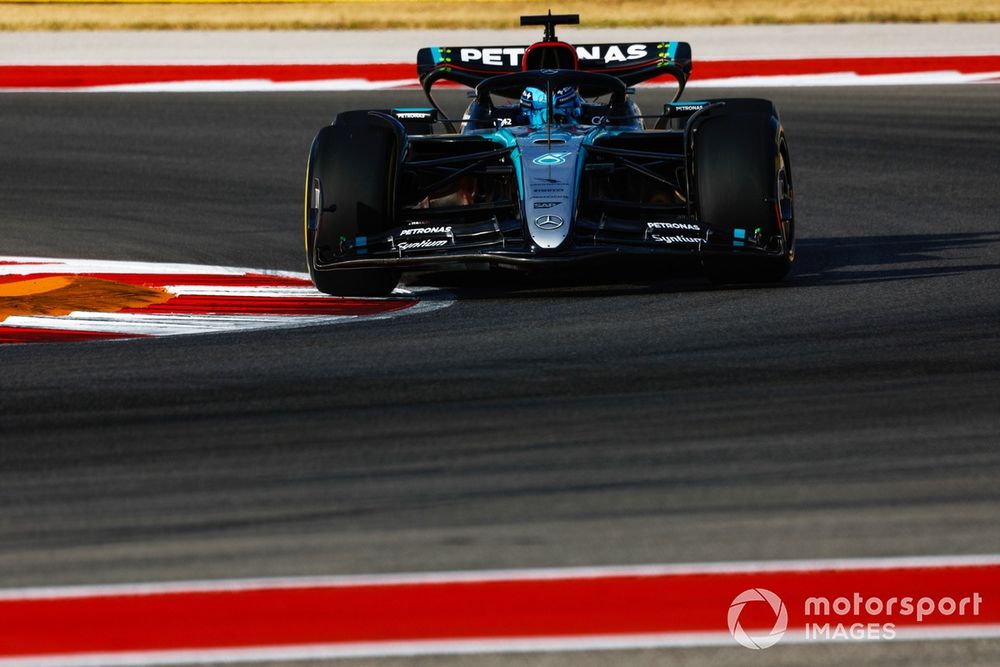
Max Verstappen edged Mercedes driver George Russell to the United States GP sprint pole by just 0.012 seconds, with GPS trace data revealing that his approach to just one critical corner made the difference.
The result meant Verstappen claimed his first pole – although sprints do not count towards official pole tally statistics – since he topped GP qualifying in Austria, as he lost his Spa GP pole due to his engine-change grid penalty.
It came on a day when Red Bull Racing was under considerable fire from 2024 title rival McLaren over Red Bull’s controversial front bib ride height adjuster.
Verstappen responded commandingly – in the RB20 that features a reworked floor edge. Russell was also on the up with the much heavier update on the Mercedes, while McLaren’s many design tweaks left Lando Norris feeling they had made little, if any, difference to the MCL38’s performance level.
With Oscar Piastri out in Q1 due to a track limits infraction and Norris not to feature in the sprint pole fight as the sun set on Friday evening at Austin, SQ3 was about two drivers that ran at very different times.
Russell led the drivers out of the pits early for the only runs on the soft tyres and shot down the pit straight quicker than Verstappen would do running with the main pack at the end of the short – per the GPS trace data logged on the cars.
However, an oversteer snap exiting the first corner was to prove costly.
It was a spot the W15s had been struggling with all day, which Pirelli says is the lowest grip part of the resurfaced areas of the circuit. The moment wasn’t as dramatic as his Turn 1 spin in FP1, but it certainly had an impact.
Having undercooked tyres for the start of the lap will also leave the drivers grappling here – the slides also then sending temperature spikes through the rubber that can become critical later.
On the approach to the rapid left at the start of the Esses, Russell had shipped almost 0.2s to Verstappen, which had come down to 0.17s by the end of the sequence.
George Russell, Mercedes F1 W15
Photo by: Zak Mauger / Motorsport Images

But from there, Russell’s speed on the straights plus a better traversing of Turn 11 mean he erased his previous losses by the end of the main straight, and while Verstappen’s run through Turns 12-15 was better, Russell rocketing through Turns 16-18 meant he held a narrow 0.046s advantage.
Next up was Turn 19, and the scene of the earlier track limits controversy that was to make the critical difference for Verstappen.
He chucked his RB20 in the plunging apex and shot through 3mph faster than Russell on a tighter line to come out with a fractional advantage.
When Russell’s ever so slightly quicker run through the final corner made next to no difference to their gap on essentially the same lines, Verstappen’s narrow triumph was sealed.
“From lap one, I think the car was in a decent window,” Verstappen said of what made the critical difference late on Friday. “I felt quite comfortable. I could attack the high-speed corners. I think we’re quite quick there.”
Mercedes insiders remain confident that it is in the fight this weekend — particularly as there is so little data on long-run pace thanks to the sprint format, which is leaving Red Bull wary at this stage.
The Silver Arrows squad is also delighted to have got through the Monza/street-circuit run that followed Zandvoort, as the “90° corners” that don’t suit “underlying characteristics of our car that are hurting us” in races at such tracks don’t suit the W15 – per Mercedes trackside engineering director, Andrew Shovlin.
Motorsports
Lance Stroll talks superstitions and his fashion evolution
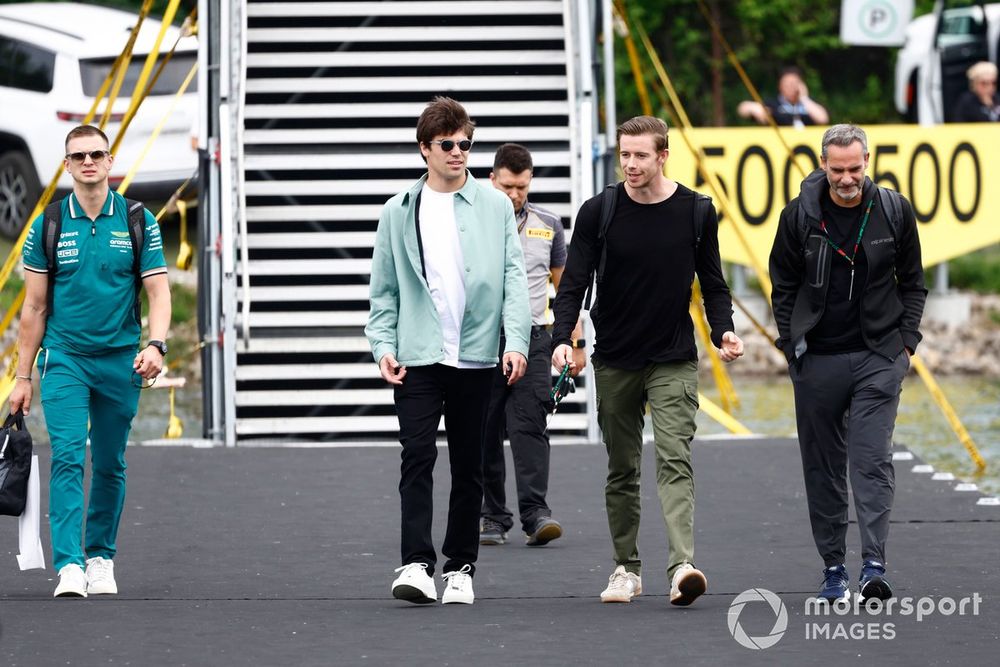
Lance Stroll is the first person to admit his sense of style has come a long way since he joined the Formula 1 grid almost a decade ago. The 25-year-old Aston Martin Racing driver, whose resume includes three podiums from more than 160 race starts, was a self-confessed “sweatpants and t-shirt guy” in the early years of his career.
Although he’s still a fan of relaxed silhouettes and laid-back ensembles, it’s clear he’s taken some cues from his dad, fashion mogul turned F1 team owner, Lawrence Stroll. “I’ve always been around good taste in fashion,” Lance told Motorsport at BOSS’ Austin store ahead of the US Grand Prix. “I’ve been taught to have an eye for what looks good.”
Lance Stroll, Aston Martin F1 Team, arrives at the track
Photo by: Zak Mauger / Motorsport Images

Lawrence made his billions working with the likes of Ralph Lauren, Michael Kors and Tommy Hilfiger, cementing his place in the fashion industry. Stroll Sr. became such a staple of the business that in 2004, he was selected by Vogue editor-in-chief Anna Wintour to co-chair the Met Gala — an honour that was recently bestowed upon Lewis Hamilton, who will co-chair the 2025 event.
“Maybe I’d attend down the line,” Lance said when asked whether he has any interest in the glitzy New York City soirée. “I’m thinking more about race cars right now,” he added.
As for his on-track clothing, the Canadian revealed he has some long-held superstitions surrounding his boots, gloves and even underwear.
“You’re going to be pretty grossed out, but I try to drag [my racing boots] out for a whole season,” he said.
“They get more comfortable over time as they’re broken-in but there’s an element of superstition in there, too. If you have a good race during the season you kind of want to hang onto the boots and the gloves,” he said.
“I had lucky underwear for a bit, but that’s when I was eight years old and then I got to 13 or 14 and they started getting tight so I had to give up that superstition.”
Motorsports
McLaren explains decision to hold fire on new F1 floor at Austin
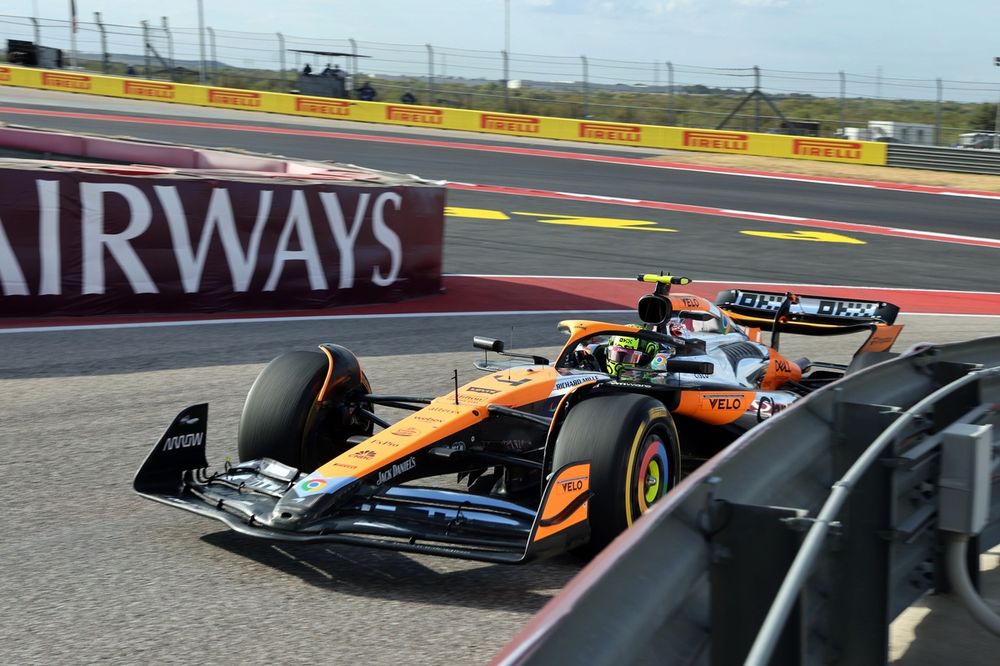
McLaren’s decision not to introduce a new floor design for the United States Grand Prix was made to assess its other new components without “any confusion”.
The Woking team brought a revised front wing and front suspension package, in addition to a series of changes to its rear brake duct furniture and rear wing.
However, McLaren stopped short of introducing a new floor design that has been in progress at its base, electing not to spend the four-week gap between Singapore and Austin fast-tracking it.
Engineering technical director Neil Houldey revealed that the team needed to be completely sure that the in-development floor works before manufacturing it.
He added that the scope of updates that McLaren brought to Austin was quite small, but “should give us a little bit of performance opportunity” further down the line.
Lando Norris appeared to confirm this yesterday after sprint qualifying, noting that the car was “basically the same” as the Singapore spec. The Briton had been given the full set of upgrades for Austin, while Piastri was without the new front wing.
Houldey felt that it was important to judge the other updates in isolation, rather than putting everything together in one package.
“We brought a lot of small upgrades for this event. I don’t really want to go into too many details about what will appear at the next events, but there’ll be more coming, for sure,” Houldey explained.

Lando Norris, McLaren MCL38
Photo by: Andreas Beil
“What we’ve been doing is just continue our development progress throughout the year and at the moment, it turns out, really, that what we want to do is bring something that we know works.
“So we’re not trying to deliver something early. We’re in a good position in the championship.
“But what we don’t want to do is bring any confusion into the team about the results of the components we’re bringing. So we’re waiting and bringing them when they’re ready.
“We want it on the car. We want the performance on the car as soon as we can possibly get it.”
Houldey denied that the limited practice available in a sprint weekend was a factor, reiterating that McLaren simply wanted to make sure any floor upgrades were worthy of being added to the car.
He felt that, although McLaren’s presence in the title battle adds scrutiny to its upgrade path, the team was dealing with it in the right way.
“We’re just ensuring that when we bring the parts, they’re the right ones, and they’re going to bring performance to the track,” Houldey continued.
“Aerodynamically, we already know the upgrades that we’re going to be bringing to the next couple of events. So they’re ready in that sense, but they’re very much in manufacture back at the factory.
“We just bring it to the event that we can get it to in the fastest possible way. So whether it’s a sprint or a standard event, doesn’t make a difference to us.
“From our perspective, we’re fully focused on our own technical development, and it’s important for us to just focus on where we are and what we bring to the races and not what other teams are doing.
“We’re learning what it’s like to be back at the front again. So for sure, the scrutiny that that brings is new to us, and I think we’re dealing with it in the right way.”
-

 Science & Environment1 month ago
Science & Environment1 month agoHyperelastic gel is one of the stretchiest materials known to science
-

 Technology3 weeks ago
Technology3 weeks agoIs sharing your smartphone PIN part of a healthy relationship?
-

 Science & Environment1 month ago
Science & Environment1 month agoHow to unsnarl a tangle of threads, according to physics
-

 Science & Environment1 month ago
Science & Environment1 month ago‘Running of the bulls’ festival crowds move like charged particles
-

 Technology1 month ago
Technology1 month agoWould-be reality TV contestants ‘not looking real’
-

 Science & Environment1 month ago
Science & Environment1 month agoMaxwell’s demon charges quantum batteries inside of a quantum computer
-

 Science & Environment1 month ago
Science & Environment1 month agoLiquid crystals could improve quantum communication devices
-

 Science & Environment3 weeks ago
Science & Environment3 weeks agoX-rays reveal half-billion-year-old insect ancestor
-

 Womens Workouts4 weeks ago
Womens Workouts4 weeks ago3 Day Full Body Women’s Dumbbell Only Workout
-

 Science & Environment1 month ago
Science & Environment1 month agoQuantum ‘supersolid’ matter stirred using magnets
-

 Science & Environment1 month ago
Science & Environment1 month agoSunlight-trapping device can generate temperatures over 1000°C
-

 Science & Environment1 month ago
Science & Environment1 month agoWhy this is a golden age for life to thrive across the universe
-

 Science & Environment1 month ago
Science & Environment1 month agoQuantum forces used to automatically assemble tiny device
-

 Science & Environment1 month ago
Science & Environment1 month agoHow to wrap your mind around the real multiverse
-

 Science & Environment1 month ago
Science & Environment1 month agoA slight curve helps rocks make the biggest splash
-

 Science & Environment1 month ago
Science & Environment1 month agoNerve fibres in the brain could generate quantum entanglement
-

 Science & Environment1 month ago
Science & Environment1 month agoLaser helps turn an electron into a coil of mass and charge
-

 Science & Environment1 month ago
Science & Environment1 month agoITER: Is the world’s biggest fusion experiment dead after new delay to 2035?
-
News1 month ago
the pick of new debut fiction
-

 News1 month ago
News1 month ago▶️ Hamas in the West Bank: Rising Support and Deadly Attacks You Might Not Know About
-

 Science & Environment1 month ago
Science & Environment1 month agoA new kind of experiment at the Large Hadron Collider could unravel quantum reality
-

 News4 weeks ago
News4 weeks agoOur millionaire neighbour blocks us from using public footpath & screams at us in street.. it’s like living in a WARZONE – WordupNews
-

 Science & Environment1 month ago
Science & Environment1 month agoTime travel sci-fi novel is a rip-roaringly good thought experiment
-

 News1 month ago
News1 month ago▶️ Media Bias: How They Spin Attack on Hezbollah and Ignore the Reality
-

 Technology3 weeks ago
Technology3 weeks agoWhy Machines Learn: A clever primer makes sense of what makes AI possible
-

 Science & Environment1 month ago
Science & Environment1 month agoNuclear fusion experiment overcomes two key operating hurdles
-

 Science & Environment1 month ago
Science & Environment1 month agoPhysicists are grappling with their own reproducibility crisis
-

 Technology3 weeks ago
Technology3 weeks agoUkraine is using AI to manage the removal of Russian landmines
-

 Technology2 weeks ago
Technology2 weeks agoThis AI video generator can melt, crush, blow up, or turn anything into cake
-

 Technology3 weeks ago
Technology3 weeks agoMicrophone made of atom-thick graphene could be used in smartphones
-

 Sport2 weeks ago
Sport2 weeks agoWales fall to second loss of WXV against Italy
-

 Science & Environment1 month ago
Science & Environment1 month agoPhysicists have worked out how to melt any material
-
Business3 weeks ago
Eurosceptic Andrej Babiš eyes return to power in Czech Republic
-

 MMA2 weeks ago
MMA2 weeks agoJulianna Peña trashes Raquel Pennington’s behavior as champ
-
Business2 weeks ago
DoJ accuses Donald Trump of ‘private criminal effort’ to overturn 2020 election
-

 Business2 weeks ago
Business2 weeks agoWhen to tip and when not to tip
-

 Sport2 weeks ago
Sport2 weeks agoCoco Gauff stages superb comeback to reach China Open final
-

 Sport3 weeks ago
Sport3 weeks agoWorld’s sexiest referee Claudia Romani shows off incredible figure in animal print bikini on South Beach
-

 TV2 weeks ago
TV2 weeks agoসারাদেশে দিনব্যাপী বৃষ্টির পূর্বাভাস; সমুদ্রবন্দরে ৩ নম্বর সংকেত | Weather Today | Jamuna TV
-

 News1 month ago
News1 month agoYou’re a Hypocrite, And So Am I
-

 Science & Environment1 month ago
Science & Environment1 month agoCaroline Ellison aims to duck prison sentence for role in FTX collapse
-

 Science & Environment1 month ago
Science & Environment1 month agoRethinking space and time could let us do away with dark matter
-

 Sport4 weeks ago
Sport4 weeks agoJoshua vs Dubois: Chris Eubank Jr says ‘AJ’ could beat Tyson Fury and any other heavyweight in the world
-

 News2 weeks ago
News2 weeks agoMassive blasts in Beirut after renewed Israeli air strikes
-

 TV2 weeks ago
TV2 weeks agoLove Island star sparks feud rumours as one Islander is missing from glam girls’ night
-

 Technology3 weeks ago
Technology3 weeks agoUniversity examiners fail to spot ChatGPT answers in real-world test
-

 Football2 weeks ago
Football2 weeks agoRangers & Celtic ready for first SWPL derby showdown
-

 News2 weeks ago
News2 weeks agoHeartbreaking end to search as body of influencer, 27, found after yacht party shipwreck on ‘Devil’s Throat’ coastline
-

 News2 weeks ago
News2 weeks agoHull KR 10-8 Warrington Wolves – Robins reach first Super League Grand Final
-

 News2 weeks ago
News2 weeks agoNavigating the News Void: Opportunities for Revitalization
-

 News1 month ago
News1 month agoNew investigation ordered into ‘doorstep murder’ of Alistair Wilson
-

 Health & fitness1 month ago
Health & fitness1 month agoThe secret to a six pack – and how to keep your washboard abs in 2022
-

 Science & Environment1 month ago
Science & Environment1 month agoA tale of two mysteries: ghostly neutrinos and the proton decay puzzle
-
News4 weeks ago
The Project Censored Newsletter – May 2024
-

 Technology3 weeks ago
Technology3 weeks agoQuantum computers may work better when they ignore causality
-

 Sport3 weeks ago
Sport3 weeks agoWatch UFC star deliver ‘one of the most brutal knockouts ever’ that left opponent laid spark out on the canvas
-

 MMA3 weeks ago
MMA3 weeks agoConor McGregor challenges ‘woeful’ Belal Muhammad, tells Ilia Topuria it’s ‘on sight’
-

 Sport2 weeks ago
Sport2 weeks agoSturm Graz: How Austrians ended Red Bull’s title dominance
-

 MMA2 weeks ago
MMA2 weeks agoDana White’s Contender Series 74 recap, analysis, winner grades
-

 Technology2 weeks ago
Technology2 weeks agoTexas is suing TikTok for allegedly violating its new child privacy law
-

 Technology2 weeks ago
Technology2 weeks agoSamsung Passkeys will work with Samsung’s smart home devices
-

 Technology2 weeks ago
Technology2 weeks agoA very underrated horror movie sequel is streaming on Max
-

 News2 weeks ago
News2 weeks ago▶ Hamas Spent $1B on Tunnels Instead of Investing in a Future for Gaza’s People
-

 News2 weeks ago
News2 weeks agoHeavy strikes shake Beirut as Israel expands Lebanon campaign
-

 Technology3 weeks ago
Technology3 weeks agoEpic Games CEO Tim Sweeney renews blast at ‘gatekeeper’ platform owners
-
Business2 weeks ago
LVMH strikes sponsorship deal with Formula 1
-

 TV2 weeks ago
TV2 weeks agoPhillip Schofield accidentally sets his camp on FIRE after using emergency radio to Channel 5 crew
-

 Technology2 weeks ago
Technology2 weeks agoAmazon’s Ring just doubled the price of its alarm monitoring service for grandfathered customers
-

 Politics2 weeks ago
Politics2 weeks agoHochul’s careful conversations
-

 News2 weeks ago
News2 weeks agoBalancing India and China Is the Challenge for Sri Lanka’s Dissanayake
-

 Technology4 weeks ago
Technology4 weeks agoRobo-tuna reveals how foldable fins help the speedy fish manoeuvre
-
Politics3 weeks ago
Robert Jenrick vows to cut aid to countries that do not take back refused asylum seekers | Robert Jenrick
-

 Technology3 weeks ago
Technology3 weeks ago‘From a toaster to a server’: UK startup promises 5x ‘speed up without changing a line of code’ as it plans to take on Nvidia, AMD in the generative AI battlefield
-
Business3 weeks ago
Should London’s tax exiles head for Spain, Italy . . . or Wales?
-

 Football3 weeks ago
Football3 weeks agoFootball Focus: Martin Keown on Liverpool’s Alisson Becker
-

 Technology1 month ago
Technology1 month agoThe ‘superfood’ taking over fields in northern India
-

 Science & Environment1 month ago
Science & Environment1 month agoFuture of fusion: How the UK’s JET reactor paved the way for ITER
-

 News1 month ago
News1 month agoIsrael strikes Lebanese targets as Hizbollah chief warns of ‘red lines’ crossed
-
Politics4 weeks ago
UK consumer confidence falls sharply amid fears of ‘painful’ budget | Economics
-

 Technology3 weeks ago
Technology3 weeks agoArtificial flavours released by cooking aim to improve lab-grown meat
-
Business2 weeks ago
Bank of England warns of ‘future stress’ from hedge fund bets against US Treasuries
-

 Business2 weeks ago
Business2 weeks agoChancellor Rachel Reeves says she needs to raise £20bn. How might she do it?
-
Politics2 weeks ago
Rosie Duffield’s savage departure raises difficult questions for Keir Starmer. He’d be foolish to ignore them | Gaby Hinsliff
-
Business2 weeks ago
CEOs turn to podcasts to control their message
-

 MMA2 weeks ago
MMA2 weeks agoPereira vs. Rountree prediction: Champ chases legend status
-

 Technology2 weeks ago
Technology2 weeks agoApple iPhone 16 Plus vs Samsung Galaxy S24+
-

 Money2 weeks ago
Money2 weeks agoWhy thousands of pensioners WON’T see State Pension rise by full £460 next year
-

 Technology2 weeks ago
Technology2 weeks agoThe best shows on Max (formerly HBO Max) right now
-
Business3 weeks ago
Ukraine faces its darkest hour
-

 Sport2 weeks ago
Sport2 weeks agoLauren Keen-Hawkins: Injured amateur jockey continues progress from serious head injury
-
Business2 weeks ago
Top shale boss says US ‘unusually vulnerable’ to Middle East oil shock
-

 Technology2 weeks ago
Technology2 weeks agoMusk faces SEC questions over X takeover
-
Business2 weeks ago
Sterling slides after Bailey says BoE could be ‘a bit more aggressive’ on rates
-

 Sport2 weeks ago
Sport2 weeks agoMan City ask for Premier League season to be DELAYED as Pep Guardiola escalates fixture pile-up row
-

 News2 weeks ago
News2 weeks agoFamily plans to honor hurricane victim using logs from fallen tree that killed him
-
Business2 weeks ago
The search for Japan’s ‘lost’ art
-

 News1 month ago
News1 month agoHow FedEx CEO Raj Subramaniam Is Adapting to a Post-Pandemic Economy
-

 CryptoCurrency4 weeks ago
CryptoCurrency4 weeks agoCardano founder to meet Argentina president Javier Milei
-

 Science & Environment1 month ago
Science & Environment1 month agoUK spurns European invitation to join ITER nuclear fusion project
-

 Sport4 weeks ago
Sport4 weeks agoUFC Edmonton fight card revealed, including Brandon Moreno vs. Amir Albazi headliner

You must be logged in to post a comment Login